The Dutch Are Weeping in Four Universal Pictorial Languages At Least
The recent research project and series of exhibitions After Neurath revisits the work of Otto Neurath, renaissance man of the Vienna Circle who had attempted to relate the puzzle of social change by pictorialising knowledge. Marina Vishmidt assesses Neurath's attempt to bridge the world between art and non-art in the terms of current debate and draws a materialist line under any positivistic expectations of the exhibition as research [1]
Coding The Circle
Epitomising the blend of radical socialism and rationalist optimism that characterised the left-leaning episteme of the first half of the 20th century, Otto Neurath was an Austrian political economist, philosopher of science and graphic designer. A member of the Vienna Circle, he was committed to an empiricist vision of social change that depended upon a working class comprehensively informed about their material conditions and the distribution of power across linguistic or national divides. With the slogan 'Words Divide, Pictures Unite', Neurath and his collaborators Gerd Arntz and Marie Reidemeister came up with ISOTYPE (International System of Typographic Picture Education), an early example of information architecture that almost utterly phased out verbal or numerical description in favour of pictograms. Adopting the succinct iconography of traffic or public toilet signs to convey unwieldy statistics, ISOTYPE was soon in demand for populist education initiatives ranging from world atlases to displays of tuberculosis mortality and military build-up at Vienna's short-lived Museum of Society and Economy. Neurath's lifelong project to radicalise by visualising fell foul of authorities in the rapidly contracting political climate of pre-WWII Europe, and his career charted a trajectory of flights from the collapse of Red Munich in 1919, the Nazi purge of socialist Vienna in the early '30s, and the Nazi occupation of Holland. He ended his days in 1945 in the tranquil environs of Oxford, following a brief internment as an enemy alien.
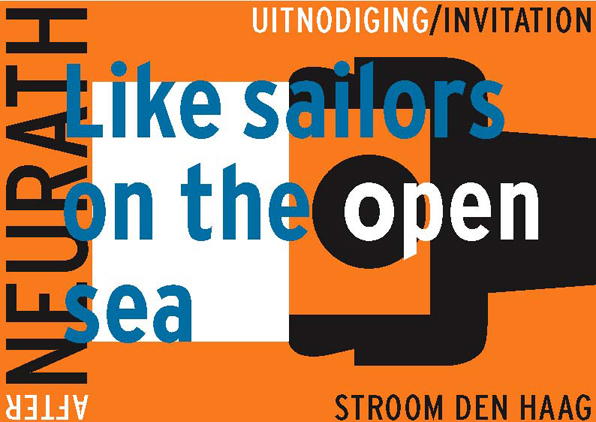 Image: After Neurath exhibition poster
Image: After Neurath exhibition poster
Although the classical logitical positivist statement remains Wittgenstein's 'the world is everything which is the case' , the Vienna Circle was not always confined to the ideological quietism that could be deduced from that statement. Neurath's work combined pragmatism with a utopian orientation, a drive to represent 'things as they are' in the hope that revolutionary progress would make out of them things of the past. The Marxist ethics behind the ISOTYPE project complemented the kinds of formal innovations – images built of numbers, standard templates, seriality – that structure the internet, another vision of universal information, albeit one without a clear ideological mission. The disambiguation of social contradictions as a premise for a materialist design practice is one of the questions that After Neurath: Like Sailors on the Open Sea tries to address in the format of an exhibition but also of a year and a half-long programme of research, symposia, and smaller exhibitions. The allure and shortcomings of a universal grammar is another, with the connotation that it is both a dream of reason and a bold proposition for engineering social change. This rueful admixture of folly and vision is a core aspect of the exhibition; another is looking at ISOTYPE as code, whether in the sense of software code, encryption or social codes to be transformed. Jon Thomson and Alison Craighead relate universal grammar to software code in Short Films About Nothing, 2007, which considers whether the use of standard templates in online environments is best suited to generate knowledge or randomness, while Stephan Dillemuth approaches the concept of universal grammar from the standpoint of quixotic attempts at extra-terrestrial communication. The relation between Neurath's project and the artists' extrapolations of it generates interesting elisions between the utopian and pragmatic, an elision that constitutes the founding fantasy of ISOTYPE as much as of 'research-based practice' on the contemporary art circuit. The juxtaposition of these precepts in a diversity of media including posters, video and local foliage, as well as Neurath's original charts mounted on walls and resting in vitrines, makes for a thematic archipelago rather than an artefact. Opacities and incongruities stick and forestall easy connections, whether it's between the projects and Neurath or to a certain vogue for exhibition-making as exhumation.
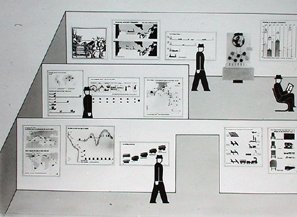
Image: ISOTYPE by Otto Neurath
Neurath's pictograms owe much to the Modernist belief that reality may be modified by being codified – standardised, easy-to-grasp templates as a revolution in human affairs. But the templates themselves, or the code, may end up in their turn aestheticised, reified, in need of a further round of de-cryption, a paradigm common also to failed revolutions. It is this double aspect of code as invisible, totalising system and an apparent mechanism for intervening in it, and the constant relay between them that opens this specious dichotomy onto a wider social history, that seems to be at issue in the show. Further, I would argue that 'code' as a thematic can be approached more expansively yet. Code as a standard and reproducible interface permits, and revokes, communication. It may confer a key, and withold it to allow for secret transmissions. It is the infrastructure of the mundane, and the hermetic interface between Truth and the initiated. It allows for the flow of goods and information between art and non-art, but it can make a living on either side.
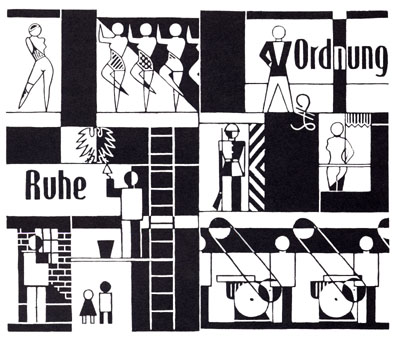
Image: ISOTYPE by Otto Neurath
Infusions of the Peripheral
What does art gain from the 'non-aesthetic set', the brave frontier of the extraneous? In 1926, Viktor Shklovsky wrote, 'It is connected with art, but the connection is not causal. . . . To stay alive, art must have new raw material'.[2] A current art-critical bromide has it that such annexation or introjection is the reflex action of mourning, a gesture to invoke an always belated spectre: the Political, the Social, the 'Real', when none seems to be forthcoming in the historical present (this conceit itself a spectre of postmodernist mourning). But is it altogether untoward to retort to such table-turning with some plump thinking? Spectrality, as always, only makes sense as inherent to materiality. Rather than the ectoplasm of displaced ideals, it is the spectral form of value, in its shifting legitimations, production modes and allegiances, that merits attention. In art milieux at some remove from the market (the generous public sector of the Netherlands, awash in 'creative' slush funds, for instance), this value form is enacted by research. The distribution of knowledge is the context and the content, and by delving into bygone enterprises of progressive fervour like Neurath's project, After Neurath reflects on its own conditions of production, as well as necessarily obscuring them. This is likewise the materiality of the code. If the code is understood as an issue for art, as it is in this project, it may envelop the undertaking of art as itself a site of meaning production under the twin auspices of the didactic (reflexive) and the oblique (disruptive) that refer to its political dimension.[3] Concomitantly with this, the code is a material instance of this constitutive scission between art as a laboratory for new sensibilities, modes of participation and forms of life, and the recalcitrance of its formal laws, a scission that would be effaced in a society 'to come'.
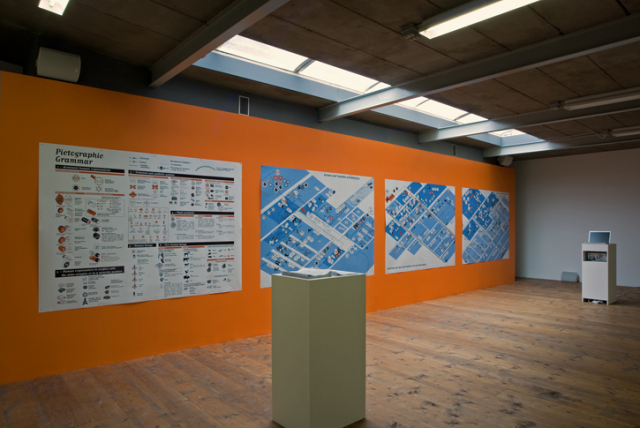 Image: After Neurath exhibition view
Image: After Neurath exhibition view
Stephan Dillemuth's participation in the show is closely preoccupied with this. His opening night performance and video screening , People of light in the slush of the sun, studies in the reform of life plus the installation Piece for Aliens dramatise the art/code nexus as an attempt to communicate of breathtaking ambition yielding equivocal results, prefiguring as it does a time that may never arrive, while the time that does arrive eradicates its faltering attempts to realise utopia in the present. Components are as follows: pre-Hitler German bohemia as an incubator of emancipatory and reactionary trends, the endeavouring to make them cast a reflection on the conditions that obtain for art and dissent in the 'corporate public' of today, a video invocation – broken by live solo numbers – of bohemians and their exploits past and present, and the early 19th century universal language prototype Solresol joining Morse code in a humble SETI (Search for Extra-Terrestrial Intelligence) device worked up out of video signal and tree branches.[4] The SETI becomes an aesthetic object with no interplanetary beings to respond to its call – but who's to know if it's speaking the right language? Just so with the Bohemians. The contradiction between transparency (a universal language or a return to nature) and 'trans-sense' (Futurist poet Khlebnikov's zaum) is the f(r)iction that grounds both the problematic autonomy of art's meanings, and the aleatory seizure of politics in its frame. Both moves depend on a 'people to come'; the timeless aporia of the avant-garde in its political guise. Code as the window and the screen for reality: this doubleness is the 'becoming-strange' which is art's surgery on the prosaic – an axiom shared by Neurath, the futurists, but also Brecht, the L=A=N=G=U=A=G=E poets, structuralist filmmakers, you name it. These impulses may be socialised or formalised to sundry degrees in each case but are delimited through and through by the spectral value form in order to even appear, and may even derive their energy from this 'possession'. The relay between the commodity form and universality is clearly what's at stake in bohemia and the retrieval of bohemia, in ISOTYPE and the retrieval of ISOTYPE, as well as in contemporary 'critical practice'. On this account, art becoms the paradigmatic non-site where non-universality is proclaimed as universality, a symptomatic code. Mediation is inscribed into the code, yet the code is supposed to overcome mediation. The project of a universal language has a very different approach to this principle than research-based art practices, but it's worth keeping in mind, especially when faced with the persistence of the desire to negate mediation – in ever-more mediated form.[5]
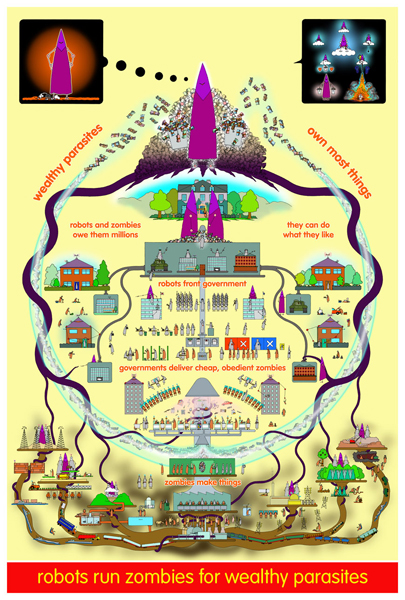
Image: Robots run zombies for wealthy parasites by Chad McCail
Research-as-art works best when it's breaking down, and Dillemuth's makeshift phantasmagoria was wise to the paradoxes that sustained his and Neurath's efforts alike – after all, Neurath could also somehow be cast as a romantic Lebensreformer. Most of the other work in the show strikes a more austere tone, entertaining a primary relation to the graphic and a secondary one to the social implications of ISOTYPE. If Neurath originated a generic visual lexicon to give the social back to itself, a number of the pieces and investigations in the show can only be depicted as sceptical but attentive to that promise. Thomson & Craighead's piece uses footage from remote-controllable webcam sites, with online or locally-sourced soundtracks and intertitles generated via algorithm from a database, manipulating the ensuing 'randomness' as a source of artistic agency. Meanwhile, Chad McCail's Snake series and Bureau D'Etudes' wall charts show the consequences of a profligacy that defeats ISOTYPE in at least two ways: an excess of subjective meaning in McCail's lurid flow charts, and untramelled complexity in the Bureau's. The effort to marry a diagrammatic grid to the 'virtually' unmappable topos of causality and control in the Bureau's Agro-food System maps seem to hint at the point where anything like a universal pictorial language must cede the field of a social 'out there' that can be modelled to a biopolitical modulation that obviously can't. Here, power is the code that cannot be represented and a 'matter' that defeats all attempts at encoding. Its architecture is so convoluted that the map comes to represent nothing but the inscription of its own ornate paranoia, no matter how factual its content. If diagrams can transcend the social through representing it, Bureau d'Etudes are dwelling under the 'absolutely empty sky' that Benjamin ascribes to the catastrophic entropy of a world abandoned by any transcendence. This is a world seething with chaos and characters, but never forms a coherent whole in its immediate context or towards a future that would justify it.[6] The Bureau d'Etudes charts also skewer the aestheticised nostalgia for a legible social reality that the modern-day use of the diagrammatic form represents, though sometimes this nostalgia vies with pedantry, most visibly in Creischer and Siekmann's updating of ISOTYPE to display contemporary statistics of violence and inequality. A breezy pedantry also pervades Oliver Ressler's mobile video archive Alternative Economics, Alternative Societies which fills the whole basement of Stroom with flakproof talking heads such as Maria Mies and John Holloway, and goes a long way to pointing out that the problem of art is not just a wavering between the legible and the disruptive, but is more urgently the problem of site and valorisation of knowledge, of why insularity and visibility go hand in hand if the artworld is the only place left for 'alternative' visions. Surely if Neurath was around today, Ressler would have lost no time in slotting him into the archive.
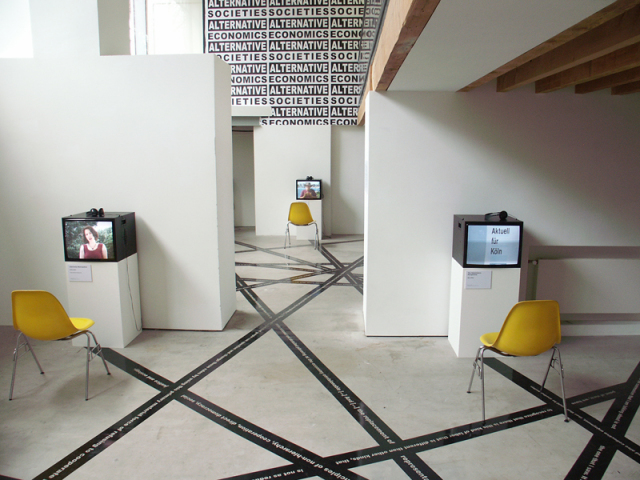 Image: After Neurath exhibition view Oliver Ressler
Image: After Neurath exhibition view Oliver Ressler
Like Sailors on the Open Sea and the After Neurath research project more generally, alights on current debates on the political dimensions of knowledge production, the mediation of art as research, and the social-shaping properties of information technologies. In taking Otto Neurath as its magus, it deliberately sidesteps an immersion in the artistic avant-gardes to make an inquiry into the genealogy of the 'solution'-led approach to social grievances that provides the common sense of everything from design to global governance today. Of course Neurath had a Communist agenda, and today's technocrats one of consumer choice and market-oriented consent, but both adhere to a discourse of liberation. Yet the dimension of social change pre-empted in the managerialist approach renders the two fundamentally unlike.
In terms of its address to a contemporary art horizon of pluralist tarrying with the political, the exhibition seems inclined to draw a line, if not quite reframe the terms from the ground up. On the face of it, it has the technological clairvoyance, the social engagement, the lure of Modernist design; what's not to like for a contemporary artworld steeped in the autophagy of radical traditions? Myriad foodstuffs for the guarded melancholics of appropriation, the furtive hoarders of research-led practice, the happy militants of perversion, and the cryptic archivists of the irreducible gap – all these tendencies snake through Like Sailors on the Open Sea. However, its ambitions go beyond a roadshow of future shock postponed until further notice of revolution. The minimal, considered and painstakingly lucid air of the show remind one of a learned society wielding the exhibition idiom as a research bulletin, a means of communicating results in a public and tangible way. It is this feeling of a thought process adopting the shape of an exhibition that lends a guarded vitality to its speculations. This quality places it at salutary distance from becoming another picnic at the leafy tombside of interred ideals, and corresponds more closely to Neurath's sober yet fantastical aim to convert all human knowledge into flat pictures in order to help humans flattened by history to become its agents.
After Neurath: Like Sailors on the Open Sea is at Stroom Den Haag in the Hague from February 25 – April 8 2007. More information and an online dossier available at www.stroom.nl. The exhibition is part of the year-long research project 'After Neurath' organised by Steve Rushton at Stroom. It continues until October 2007 and comprises of a number of activities, including further exhibitions and a talks programme.
[1] The title of this article is an adaptation of a line from the 1983 Fall song 'Tempo House' and has often come to mind during my time in the Netherlands.
[2] Viktor Shklovsky, Third Factory, Dalkey Archive Press, 1977, p53.
[3] In The Politics of Aesthetics, Jacques Ranciere elaborates further, though not much further, on this innocuous insight.
[4] SETI@HOME project http://setiathome.berkeley.edu/
[5] Like for instance 'social' web-based media. Or even socially ameliorative art. It is traditionally the prerogative of forms of cultural activity most intimate to capital (venture capital and YouWeb, public art and developer-led urbanism) that strives to dissolve its mediations in an unproblematic address to the self-activity of individuals or communities. 'Traditionally' may be a misnomer, since the relative novelty of these forms may go some way towards explaining their naivete. Traditionally art fetishises the mediations of its relationship to the market, not disavows it.
[6] The reference is from Giorgio Agamben's State of Exception, trans. Kevin Attell, University of Chicago Press, 2005, but traces its source to Walter Benjamin's The Origin of German Tragic Drama.
Marina Vishmidt <marinar AT artserve.net> is researching labour, temporality and antagonism as forms of production in contemporary art. She is currently based in the Low Countries
Mute Books Orders
For Mute Books distribution contact Anagram Books
contact@anagrambooks.com
For online purchases visit anagrambooks.com






